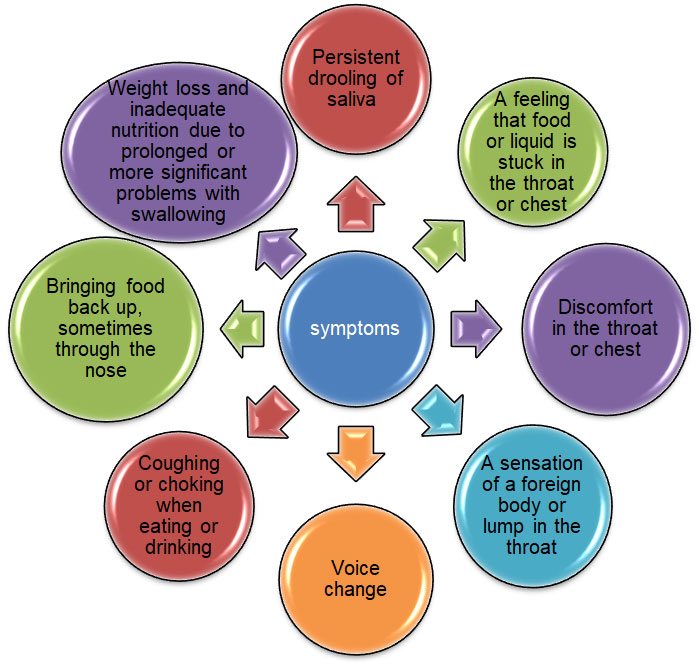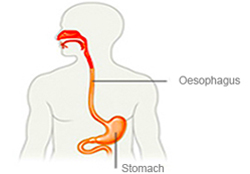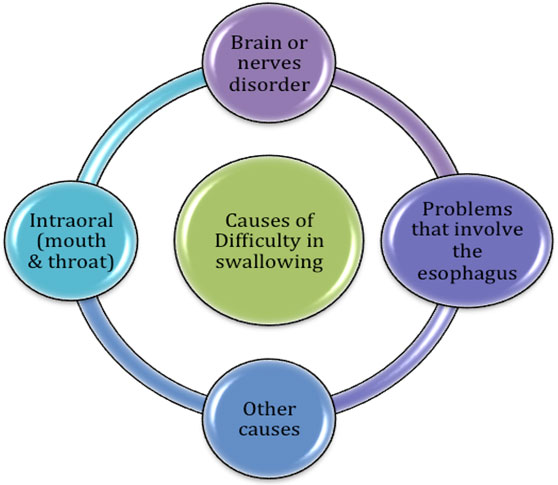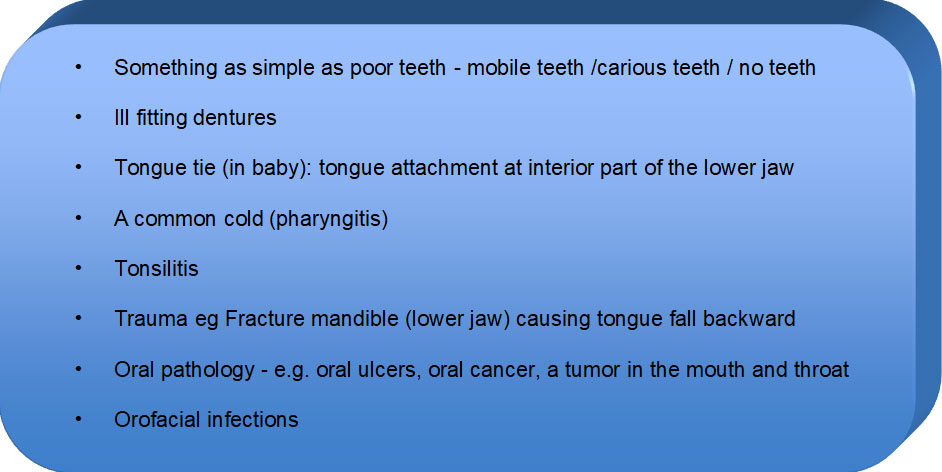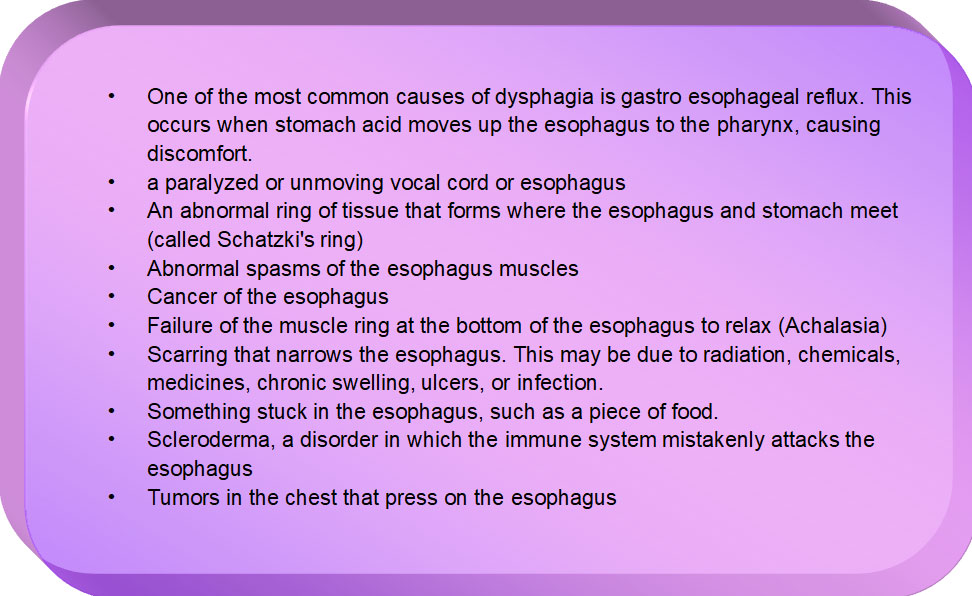Difficulty with swallowing is the feeling that food or liquid is stuck in the throat or at any point before the food enters the stomach. This problem is also called dysphagia. Although dysphagia can happen to anyone, it is most common in older adults, babies, and people who have problems of the brain or nervous system.
How do we swallow?
People normally swallow hundreds of times a day to eat solids, drink liquids, and swallow the normal saliva and mucus that the body produces. Swallowing disorders, also called dysphagia, can occur at different stages in the swallowing process :
The process of swallowing has four related stages:
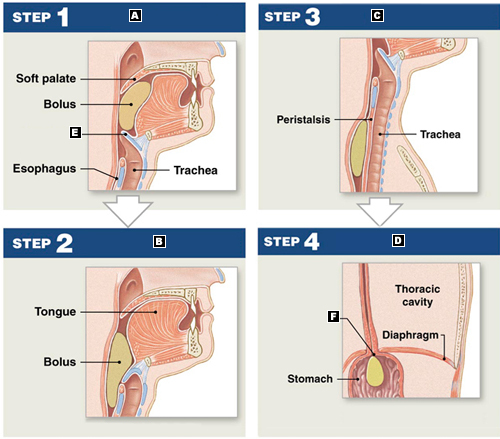
-
The first stage is the oral preparation stage, where food or liquid is manipulated (sucking, chewing, moving) in preparation for swallowing.
-
The second stage is the oral stage, where the tongue propels the food or liquid to the back of the mouth (moving food or liquid into the throat), starting the swallowing response.
-
The third stage is the pharyngeal stage, which begins as food, or liquid is quickly passed through the pharynx (the region of the throat which connects the mouth with the esophagus, then into the esophagus or swallowing tube). During this stage, the swallowing reflex done by squeezing food down the throat, and closing off the airway to prevent food or liquid from entering the airway (aspiration) or to prevent choking.
-
In the final, esophageal stage, the food or liquid passes through the esophagus by relaxing and tightening the openings at the top and bottom of the feeding tube in the throat (esophagus) and squeezing food through the esophagus into the stomach.
What are the symptoms of swallowing disorders?
Symptoms of swallowing disorders may include:
Other symptoms may include:
-
Cough or wheezing that becomes worse
-
Coughing up food that has not been digested
-
Heartburn
-
Nausea
-
Sour taste in the mouth
Children who have difficulty swallowing when eating may:
-
Refuse to eat certain foods
-
Have food or liquid leaking from their mouths
-
Regurgitate during meals
-
Have trouble breathing when eating
-
Lose weight without trying
What causes swallowing disorders?
There are many different problems that can prevent the throat or esophagus from working properly. Some of these are minor, and others are more serious. If you have a hard time swallowing once or twice, you probably do not have a medical problem. But if you have trouble swallowing on a regular basis, you may have a more serious problem that needs treatment.
Dysphagia can be caused by problems with the:
- Mouth or throat, known as oropharyngeal or “high” dysphagia
- Oesophagus (the tube that carries food from your mouth to your stomach), known as oesophageal or “low” dysphagia
Swallowing is a complex act. There are many nerves that help the muscles of the mouth, throat, and esophagus work together. Much of swallowing occurs without you being aware of what you are doing. However, difficulties may be due to a range of other causes, including:
Brain or nerves disorder:
Intraoral (in mouth & throat):
Problems that involve the esophagus:
Other causes:
How is it treated?
Your treatment will depend on what is causing your dysphagia. Treatment for dysphagia includes:
-
- Exercises for your swallowing muscles.
If you have a problem with your brain, nerves, or muscles, you may need to do exercises to train your muscles to work together to help you swallow. You may also need to learn how to position your body or how to put food in your mouth to be able to swallow better.
- Changing the foods you eat.
Your doctor may tell you to eat certain foods and liquids to make swallowing easier.
- Dilation.
In this treatment, a device is placed down your esophagus to carefully expand any narrow areas of your esophagus. You may need to have the treatment more than once.
- Endoscopy.
In some cases, a long, thin scope can be used to remove an object that is stuck in your esophagus.
- Surgery.
If you have something blocking your esophagus (such as a tumor), you may need surgery to remove it.
- Medicines.
If you have dysphagia related to GERD, heartburn, or esophagitis, prescription medicines may help prevent stomach acid from entering your esophagus. Infections in your esophagus are often treated with antibiotic medicines.
- Exercises for your swallowing muscles.
**In rare cases, a person who has severe dysphagia may need a feeding tube because he or she is not able to get enough food and liquids.
| Last Reviewed | : | 11 September 2017 |
| Writer | : | Dr. Rohaizar bt. Ismail |
| Accreditor | : | Dr. Yuen Kar Mun |


